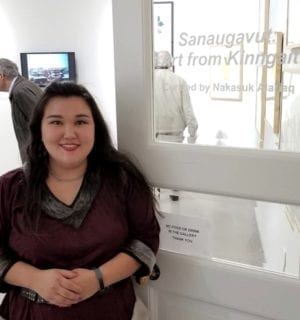Sanagavut: Art from Kinngait is a master’s thesis paper and exhibition by me, Nakasuk Alariaq, an Inuk-Finnish graduate student at Western University in London, Ont.

photo courtesy of Nakasuk Alariaq
The exhibition ran from May 3 to June 16 at Western University’s McIntosh Gallery. The exhibit and paper complement one another because the exhibit is a visual experience and the paper is written and highlights the stories and lives of the artists who were featured in the show.
Sanaugavut is very important to advocates of Indigenous self-representation in universities and galleries because it showcases Sikusiilaq (Kinngait, or Cape Dorset) histories that have largely been ignored in literature, from an Inuk’s perspective.
Researching and learning about the ways Inuit art has been written about and represented in academic settings and in the highly-competitive art industry has been fascinating. It has shown me that Sikusiilamiut have been active contributors to the growing Inuit art market in many different areas. From contributing to the Hudson’s Bay Company in the early 1900s and creating the West Baffin Co-operative and its printshop in the mid-1900s, these were huge milestones for the development of art produced in the North. There emerged master stone-cut printmakers within the Co-op’s small studio and Inuit craftsmen, such as Oshuitok Ipeelee and Lukta Qiatshuk, who specialized in making traditional tools and carvings before the Co-operative even started. They were recognized as master carvers to the nation and are the forefathers of many of the artists working today. It is like art runs through families and between generations. It is really cool.
Some of the artists I chose to focus on in Sanaugavut included Eliyah Mangitak and her beaded amauti (2010s); Annie Manning Lampron’s Inujait (1997 and 2000s); Tim Pitseolak’s women's ivory necklace pendant (2014); Mary Oshutsiaq for her beadwork and serpentine sculpture alongside Axangayu Shaa’s Dancing Walrus (2018); and Pitaloosie Saila’s Young Arctic Owl (1980). This was done to show that sewing and jewelry-making are equal art to the fine art industry that was formerly the only artforms recognized by the art historians and academics in the south.
There is a large gap between written accounts of sewing and textile artists and jewelry-makers in comparison with printmakers and sculptors. I am hoping that this gap shrinks more over time and allows others from Sikusiilaq to write about our histories like I have, such as camp leader, historian and photographer Peter Pitseolak, graphics artist Pitseolak Ashoona and Kananginak Pootoogook, to name a few. These brilliant Inuit are the people who inspired me to continue my post-secondary studies in history and curatorial studies despite my personal problems. I try to model the way I discuss art and culture like they did. I was raised in Sikusiilaq from birth to age 14, which left me with a strong sense of my culture and traditions and I am proud to be from Sikusiilaq.
Fast-forward to today, I have now spent the first half my life living in Sikusiilaq and the second half living in London, Ont., pursuing my educational goals. It is a weird dynamic of north-south relations and perspectives but I think it offers an interesting outlook for scholars and critics. I am planning on doing my PhD at Concordia University in 2019 under Dr. Heather Ingloliorte, the first Inuk art historian and a wonderful and supportive person who I cannot wait to work with. I think it’s important that more people from Nunavut and other Inuit Nunanga pursue post-secondary education so we can represent ourselves in politics, medicine, education and business.